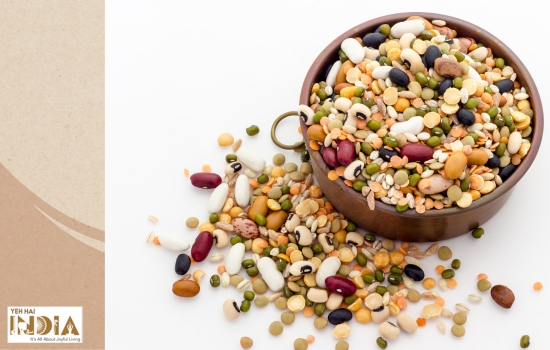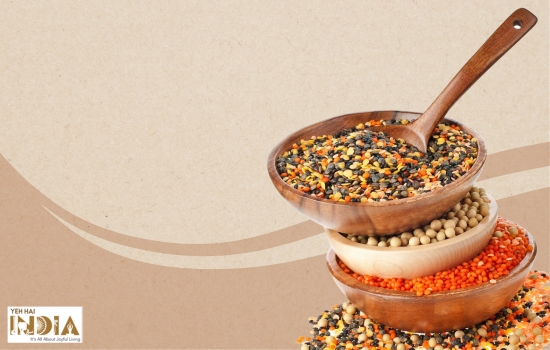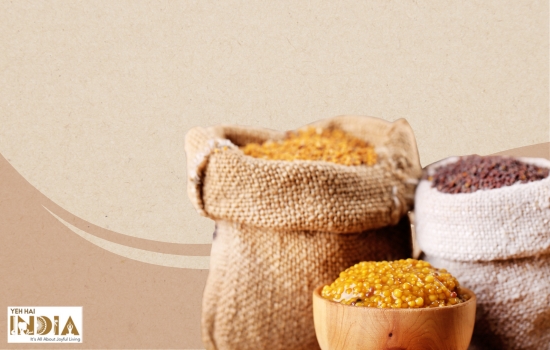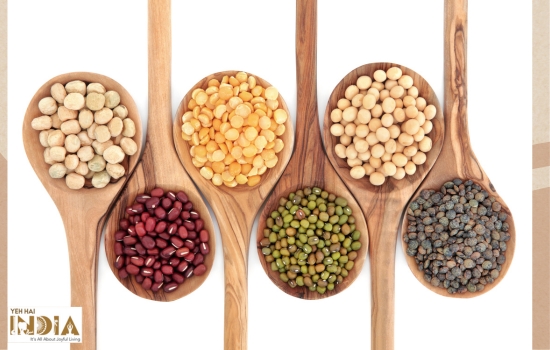India, with its diverse culinary landscape and vibrant cultural tapestry, is home to a remarkable array of pulses. These nutrient-packed legumes form an integral part of Indian cuisine and also contribute significantly to the nation’s agricultural economy. These edible seeds from legume-family plants come in a variety of shapes, sizes, and hues, and are exclusively harvested as dry grains.
But don’t be fooled by their size. Pulses are a powerhouse of nutrition, boasting high levels of protein, fibre, vitamins, and minerals. They are a perfect addition to any diet, no matter your culinary preferences or budget.
What’s more, pulses are versatile and easy to prepare, making them a great ingredient in soups, salads, and stews. Whether you’re a seasoned chef or a beginner in the kitchen, pulses are an excellent choice for adding a healthy and delicious twist to your meals.
So, if you’re looking for a simple, healthy, and affordable way to level up your diet, creatively incorporate pulses into your meal plan today!
TYPES OF PULSES
Did you know that the United Nations Food and Agriculture Organization (FAO) has identified 11 types of pulses? These include dry beans, dry broad beans, dry peas, chickpeas, cow peas, pigeon peas, lentils, Bambara beans, vetches, lupins, and other minor pulses.
Recommended Article: Fortified Breakfast Cereals: Are They What They Seem to Be?
Pulses are edible seeds in pods and are full of nutrients like protein, fibre, vitamins, and minerals. Plus, they’re super versatile and tons of different recipes come from these delicious seeds, starting from soups and stews to salads and dips.
1. Rajma or Kidney Beans
One of the most popular dried beans in India!
Rajma (kidney beans) are popular in India due to their delicious taste, versatility in various dishes, and high nutritional value. It is a staple in many Indian households in dishes like rajma masala, rajma chawal, and rajma tikki.

Nutritional Value
Here’s a breakdown of the nutritional value of 100 grams of boiled rajma:
- Calories: 127 kcal
- Carbohydrates: 22.8 g
- Protein: 8.7 g
- Fat: 0.5 g
- Fibre: 6.4 g
- Iron: 2.5 mg
- Magnesium: 70 mg
- Phosphorus: 140 mg
- Potassium: 406 mg
- Zinc: 1.2 mg
Rajma is also a good source of other important nutrients like folate, vitamin B6, and calcium.
Rajma (kidney beans) are highly nutritious and are an excellent source of plant-based protein, dietary fibre, and various essential vitamins and minerals. Additionally, rajma is also an affordable source of nutrition, which adds to its popularity in the country.
2. Pinto Beans
Want to try something new in your everyday meals? Swap Rajma for pinto beans! You can make a creamy and healthy sabzi that’s a treat for your taste buds. It’s rare in Indian cuisine, but worth a try.
Inspired by the American Cuisine
Pinto beans are creamy and slightly sweet beans that are popular in North and South American dishes like chili and burritos. They are a good source of protein, fibre, iron, and other essential nutrients. Although they are not common in India, pinto beans are available in some speciality stores that import food items.
Nutritional Value
Pinto beans are highly nutritious and are a good source of several essential nutrients. Here’s a breakdown of the nutritional value of 100 grams of boiled pinto beans:
- Calories: 143 kcal
- Carbohydrates: 26 g
- Protein: 9 g
- Fat: 1 g
- Fibre: 9 g
- Iron: 1.5 mg
- Magnesium: 48 mg
- Phosphorus: 155 mg
- Potassium: 436 mg
- Zinc: 1.1 mg
In addition to the nutrients listed above, pinto beans also contain folate, vitamin B6, and calcium. They are also low in fat and calories, making them a healthy addition to any diet.
3. Matar or Vatana
Peas that nourish the soul
“Matar” is the Hindi word for green peas, which are a good source of plant-based protein, dietary fibre, and several essential vitamins and minerals. They are also low in fat and calories, making them nutritious and versatile vegetables to include in various dishes.
Nutritional Value
Green peas, also known as “matar” in India, have a similar nutritional profile to green peas found in other parts of the world.
A one-cup serving (164g) of cooked green peas provides approximately:
- Calories: 143 kcal
- Carbohydrates: 26 g
- Protein: 9 g
- Fat: 1 g
- Fibre: 9 g
- Vitamin C: 58% of the daily value (DV)
- Vitamin K: 24% of the DV
- Vitamin A: 13% of the DV
- Folate: 22% of the DV
- Iron: 9% of the DV
- Magnesium: 11% of the DV
- Phosphorus: 15% of the DV
- Potassium: 9% of the DV
- Zinc: 8% of the DV
These nutrients make green peas a nutritious and delicious addition to various Indian dishes, such as matar paneer and aloo matar.
Recommended Article: Why Red Rice? Discover Varieties, Health Benefits and More
4. Chickpeas
An essential ingredient for healthy snacking
Chickpeas, also known as garbanzo beans or “chana” in Hindi, are a popular ingredient in Indian cuisine. Whether you’re a vegetarian or a meat-eater, chickpeas are a great addition to a healthy and balanced diet.
Nutritional Value
Chickpeas are a nutrient-dense food that provides a range of important nutrients. A one-cup serving (164g) of cooked chickpeas provides approximately:
- Calories: 269 kcal
- Carbohydrates: 45 g
- Protein: 15 g
- Fat: 4 g
- Fibre: 13 g
- Vitamin K: 71% of the daily value (DV)
- Folate: 70% of the DV
- Iron: 26% of the DV
- Phosphorus: 28% of the DV
- Copper: 29% of the DV
- Manganese: 84% of the DV
Chickpeas are also a good source of other important nutrients, such as potassium, magnesium, and vitamin B6. They are a great addition to a balanced diet, particularly for vegetarians and vegans who may have higher protein and iron needs.
Popular Roles in Indian Cuisine
Chickpeas, or “chana” in Hindi, are versatile ingredients that can be used in a wide range of dishes in Indian cuisine. Here are some popular chickpea dishes in India:
1. Chana Masala – a spicy and flavorful curry made with chickpeas, tomatoes, onions, and a blend of aromatic spices.
2. Chole Bhature – a popular North Indian dish that consists of spicy chickpeas (chole) served with fried bread (bhature).
3. Chana Chaat – a popular street food snack made with boiled chickpeas that are mixed with spices, chutney, and crunchy toppings like onions and sev.
These are just a few examples of the many delicious chickpea dishes that you can find in India.
5. Pigeon Peas
The main catalyst in dals!
Pigeon peas, also known as “arhar dal” or “toor dal” in India, are a type of legume that is widely used in Indian cuisine. Pigeon peas are a good source of plant-based protein, dietary fibre, and various vitamins and minerals.

They have a mild and slightly nutty flavour, which makes them a versatile ingredient that can be used in a variety of dishes. In Indian cuisine, pigeon peas are commonly used to make dal (a type of lentil soup), as well as curries, stews, and salads.
Nutritional Value
Pigeon peas are a nutritious and delicious addition to any Indian meal. A one-cup serving (200g) of cooked pigeon peas provides approximately:
- Calories: 231 kcal
- Carbohydrates: 41 g
- Protein: 11 g
- Fat: 1 g
- Fibre: 15 g
- Vitamin C: 10% of the daily value (DV)
- Folate: 90% of the DV
- Iron: 24% of the DV
- Magnesium: 23% of the DV
- Phosphorus: 28% of the DV
- Potassium: 23% of the DV
Pigeon peas are also a good source of other important nutrients, such as vitamin B6, thiamin, and manganese.
6. Lentils
Poor man’s meat!

In India, lentils are known by various names depending on the region and language. Some of the commonly used names for lentils in India include:
Dal: This is a generic term used for lentils in India. It can refer to any type of lentil, such as moong dal, urad dal, chana dal, or masoor dal.
Masoor dal: This refers specifically to red lentils, which are commonly used in Indian cuisine.
Moong dal: This refers to split mung beans, which are small green lentils that are commonly used in soups, stews, and curries.
Urad dal: This refers to black lentils that are commonly used to make dal makhani, a rich and creamy lentil dish.
Chana dal: This refers to split chickpeas, which are commonly used in dal, salads, and snacks.
Going into details of lentils will be a never-ending project. Their uses, benefits and their part in Indian cuisine are so very extensive. Overall, lentils are an important and widely used ingredient in Indian cuisine and are consumed in various forms and preparations across the country.
7. Bambara Beans
A Rare Bean Variety Native to the Africans but also found in Madhya Pradesh and Gujarat
Bambara beans, also known as Vigna subterranea, are not commonly used in Indian cuisine. They are native to Africa and are primarily grown in West Africa, but are also cultivated in other parts of the world.
In India, other types of legumes like chickpeas, lentils, and kidney beans are more popular and commonly used in traditional dishes. However, Bambara beans are gaining popularity as a nutritious and sustainable crop and may become more widely available in India in the future.
Nutritional Value
A one-cup serving (185g) of cooked bambara beans provides approximately:
- Calories: 333 kcal
- Carbohydrates: 63 g
- Protein: 19 g
- Fat: 2 g
- Fibre: 15 g
- Calcium: 6% of the daily value (DV)
- Iron: 37% of the DV
- Magnesium: 43% of the DV
- Phosphorus: 44% of the DV
- Potassium: 16% of the DV
Bambara beans are also a good source of other important nutrients, such as vitamin B6, thiamin, and zinc. They are particularly rich in iron and protein, making them a great addition to a balanced diet, particularly for vegetarians and vegans who may have higher iron and protein needs.
While they are not commonly used in Indian cuisine, Bambara beans are a nutritious and sustainable crop that can be used in a variety of dishes, such as stews, soups, and salads.
Recommended Article: Nutrition Bowls: A Guide To Make Your Own Mini-Meal
Minor Pulses
In addition to the major pulses commonly used in Indian cuisine, there are also several minor pulses that are less well-known or less frequently used. These minor pulses include:
1. Cowpeas (Vigna unguiculata)
Also known as black-eyed peas or southern peas, cowpeas are small, oval-shaped beans with a creamy texture and nutty flavour. They are commonly used in southern Indian cuisine and can be prepared in a variety of dishes, such as stews, curries, and salads.
2. Mung beans (Vigna radiate)
Mung beans are small, green beans common in Chinese, Korean, and Indian cuisine. They are high in protein and fibre and are part of a variety of dishes, such as dal, soups, and stir-fries.
3. Urad dal (Vigna mungo)
Urad dal, also known as black gram, is a small, black bean that is commonly used in Indian cuisine to make dal, soups, and savoury pancakes. It has a slightly sweet flavour and creamy texture.
4. Masoor dal (Lens culinaris)
Masoor dal, also known as red lentils, is a small, orange-coloured lentil and is commonly used in Indian cuisine to make dal, soups, and stews. It has a mild, slightly sweet flavour and cooks quickly.
5. Moth beans (Vigna aconitifolia)
Moth beans, also known as matki or Turkish gram, are small, brown beans and are very common in Indian cuisine to make curries and stews. They have a nutty flavour and a creamy texture when cooked.
These minor pulses are all nutritious and versatile ingredients and are part of a variety of dishes to add flavour, texture, and nutrition.
Also Read: Veganism- How are Indians adapting to this diet?
That’s all for today folks! Pulses are the major food group next to cereals especially in Indian cuisine. We Indians do not find a meal complete without our dals and dal-infused curries. Full of fibres, proteins and good carbs, these are filling, make hunger pangs stay away and are a complete ingredient to always include in our diets.
More Interesting Facts
There is another variety of pulses not grown in India at all. It is found only in parts of South America, For those who are interested in the facts, scroll down for more details on Lupins.
Lupins
More commonly available in Europe, South America and Australia!
Lupins, also known as Lupinus species, do not commonly grow in India. They are not a part of the Indian cuisine as well. They grow in temperate regions of the world, such as Europe, South America, and Australia.
While lupins have been studied for their potential use as a human food source due to their high protein and fibre content, they are not yet widely consumed by humans in India or other parts of the world. Usually in Latin America and Africa, you can find lupins to be available as a pickled snack.
Indian cuisine commonly incorporates lentils, chickpeas, and other types of legumes due to their availability and cultural significance.
Nutritional Value
Lupins, also known as Lupinus species, are a nutritious food that provides a range of important nutrients. A one-cup serving (166g) of cooked lupin beans provides approximately:
- Calories: 198 kcal
- Carbohydrates: 29 g
- Protein: 18 g
- Fat: 4 g
- Fibre: 13 g
- Calcium
- Iron
- Magnesium
- Phosphorus
- Potassium
Lupins are also a good source of other important nutrients, such as vitamin B6, folate, and zinc. It is important to note that some people may be allergic to lupin and should avoid consuming it.
In conclusion,
Pulses are a highly nutritious and versatile food group that is an important part of traditional Indian cuisine. They are rich in protein, fibre, vitamins, and minerals, making them a valuable addition to a balanced diet. Pulses can be used in a wide variety of dishes, from dals and curries to salads and snacks, and can be prepared in many different ways to suit different tastes and preferences. Whether consumed as a staple food or as a healthy snack, pulses are an excellent choice for anyone looking to add more nutrition to their diet.
Frequently Asked Questions
Why are pulses significant in Indian cuisine?
Pulses are a category of leguminous crops that are harvested for their edible seeds. In India, pulses hold great cultural and culinary importance. They are a vital source of plant-based protein, dietary fibre, and essential nutrients.
Pulses such as lentils (dal), chickpeas (chana), kidney beans (rajma), and black gram (urad dal) are widely used in Indian cuisine, providing a rich and diverse range of flavours and textures.
What are the health benefits of consuming pulses?
Pulses offer numerous health benefits. They are low in fat, cholesterol-free, and rich in protein, fibre, vitamins, and minerals. Regular consumption of pulses can help in managing weight, controlling blood sugar levels, reducing the risk of heart disease, promoting digestive health, and providing sustained energy. Pulses also have a low glycemic index, making them a favourite food choice for individuals with diabetes.
How can pulses be included in the regular Indian diet?
Pulses are incredibly versatile and can be included in various Indian dishes. They can be used to prepare dal, curries, soups, salads, snacks (such as sprouted pulses), and even desserts (such as besan laddoo). Pulses can be cooked on their own or combined with other vegetables, spices, and herbs to create delicious and nutritious meals. They can also be ground into flours to make dishes like dosas, idlis, or besan-based snacks.
Are there any regional specialities or traditional dishes in India that feature pulses?
Yes, different regions in India have their unique pulse-based dishes. Some popular examples include Rajasthani dal baati churma, Punjabi chole (chickpea curry), South Indian sambar, Gujarati dhokla (made from chickpea flour), Maharashtrian usal, and Bengali moong dal khichdi.










